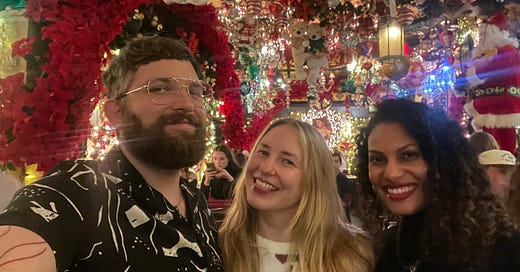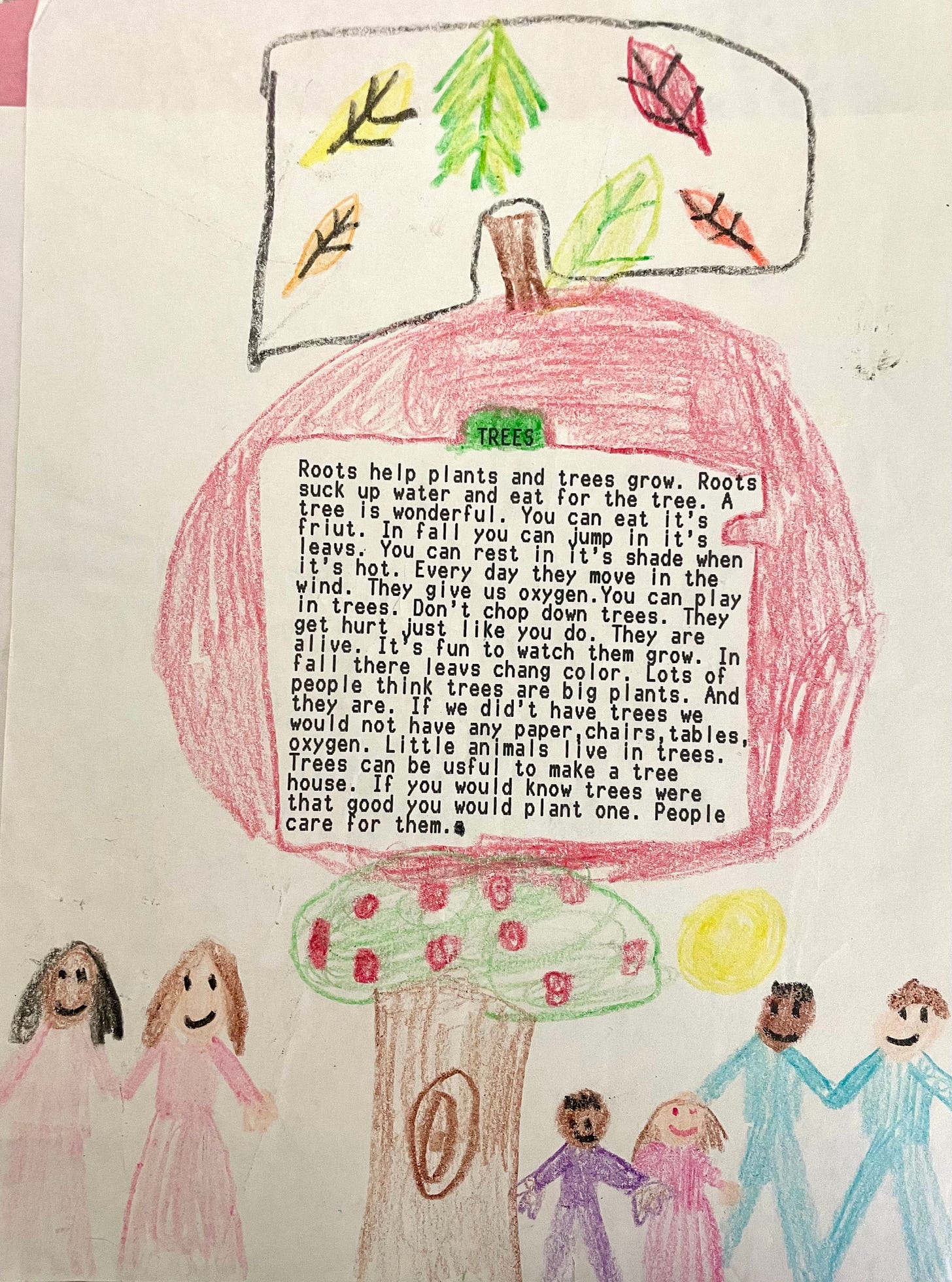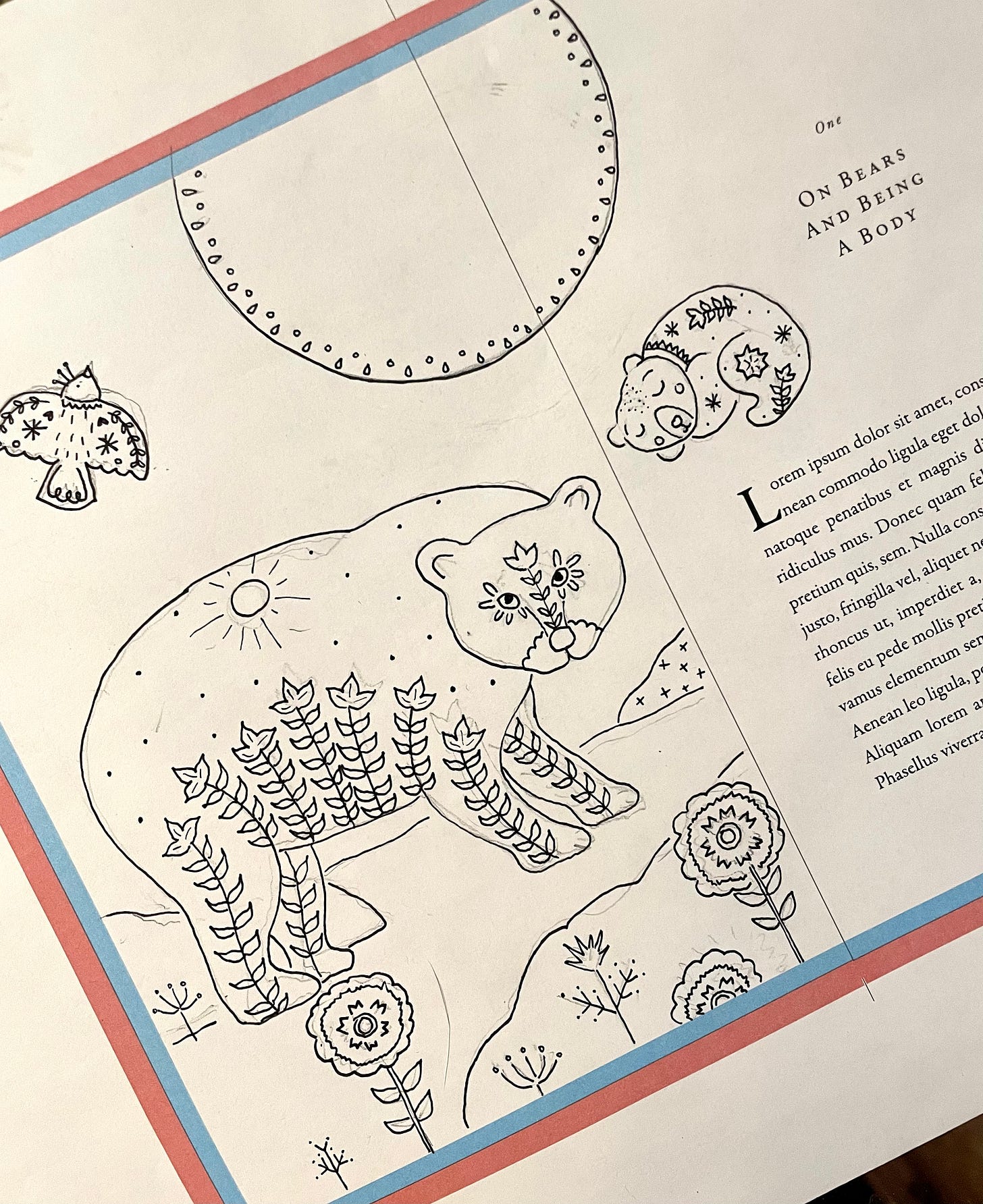Everything I Loved in December
Conversation tips, whimsical coats, and podcasts I couldn't turn off
Happy almost 2025, my beautiful Blueberries!
I hope December has been a relatively peaceful month for you, in all the holiday hullaballoo. Uncharacteristically, I have leaned pretty far in to all the razzle-dazzle of the season, even finding a way to get in to one of those holiday-explosion bars that are constantly packed from November-January!
My friends and I managed to squirm through Lillie’s—even crashing a company party that definitely does not employ any of us!!—and had a festive old time!
You could say I really had myself a nice little holiday season, and now I feel ready to be horizontal for as much as January will allow me…until I fly into a Southern Hemisphere Summer in a couple weeks.
But we’ll talk about that later!!!!
For now, my reading, listening, wearing, doing, and watching recommendations from December:
LOST IN WORDS
I got blissfully lost this month in articles and books that rambled in the finest way, getting tangled up in my mind as the word-threads tightened some opinions over here and loosened some perspectives over there.
The Shock of Faith
Despite being a Person of Faith, so they call it, I’m used to feeling alone even as a part of the world’s largest religion.
Atheists question why I bother with all this gibberish when I’m uncertain about it; religious people puzzle over how I possess such abiding faith when I doubt most of the details.
In this wonderfully labyrinthine piece, David Brooks wrote the definition of faith I wish I’d had for every one of these conversations—and I’m so relieved to have it now.
For me, and apparently many others, it’s not a set of beliefs. I don’t think Noah actually had an ark. I’m not sure that a lot of characters in the Bible existed at all. And the story of the birth of Jesus is…odd...to say the least. I still have a LOT of suspicions about the mechanics of Easter.
And I’m good with that.
As a society, we put our faith in SO many messages and myths that don’t have their roots in facts, and we uphold them anyway.
(Quick example: We just made up money one day and decided it’s real and it controls our lives. Okay then.)
Yet when it comes to religion, I observe a much more all-or-nothing assumption. “YOU BELIEVE OR YOU DON’T. IT’S REAL OR IT’S NOT.”
What if it’s not real and you still have faith? (Again, ahem, money?!?)
I can’t possibly imagine that the Creator of the Universe would be so insecure that we all have to put our absolute certain trust in this pretty insane story and in their existence in order to…go to heaven instead of a torture chamber? Not in my book.
Beliefs don’t have much to do with my faith, but I do believe the Bible is a textured, poetic, political, rich and loving collection of myths, stories, and sermons that have encouraged me to see more nuance and complexities in this beautiful love-filled world.
While “belief” is black-and-white, faith is full of contradictions and non-dualities: the great “and” of it all.
(Quick example: I strongly believe life begins at conception, and I strongly believe that abortion should be legal, safe, easy, fully supported; and free of cost, stigma, and judgment.)
Brooks’ lyrical piece gave me a much more aligned definition of what I mean when I say “faith”—a deep knowing that doesn’t exclude any other religions, traditions, doubts, or intellectual arguments, but actually embraces them.
Is it possible to believe that maybe all religions are true and none of them are true and still live your life according to the teachings of radical socialist Jesus? Well, me and David Brooks say so. :)
The Home Place: Memoirs of a Colored Man’s Love Affair With Nature
Another melodic work that did for me what poetry does best: transcend linearity and logic to dig at something more true.
I’ve become quite tired of human neurosis and much more curious about the wealth of what is: attention to the alert and awake in every form…i.e. stories about nature.
I read about this memoir by poet-ornithologist J. Drew Lanham in a sweet interview with Robin Wall Kimmerer, who said that he “reflects a sensibility to the natural world that is simultaneously scientific and deeply emotional.” I ordered it before finishing the interview.
And indeed, the clean, clear book is clearly the work of a gentle person whose path of poetry permits him to hold rage and wonder in the same sentence.
If you’d like a preview of his writing, his article “What Do We Do About John James Audubon?” is a stunning introduction to how he weaves and layers race, sociology, sticky questions, difficult history, and the beauty and soul-fueling wonders of nature.
ALL THINGS BEARS
I am increasingly obsessed with bears.
If there’s one thing I learned from the past four years of writing a book about humans and animals, it’s that the way we interact with animals says everything about us.
The way we think about, talk about, approach, and eat other critters has almost nothing to do with their behavior, but rather our own judgments, fears, cognitive dissonance, and even feelings about other humans.
I have learned SO much about this very topic from the Tooth and Claw podcast, a highly entertaining true-crime-adjacent storytime, but with animals instead of people.
But the funny, bro-y, silly podcast hosts’ aim isn’t to scare us; it’s to educate and nudge us toward greater respect for these spectacular creatures we share our earth with.
If there’s any topic more interesting to me than animals, it’s humans, and I learned so much about us from these RIVETING episodes:
Night of the Grizzly
The podcast host refers to the so-called “Night of the Grizzly” as “the 9/11 of bears.”
Meaning, Before: We thought we were safe. We thought we had nothing to worry about. We had a false sense of stability that even experts shared.
After: We realized we weren’t always safe. Security had been a myth. There was so much more to learn.
Before the Night of the Grizzly, campers and even rangers in national parks had virtually no fear of bears. Experienced hikers laughed at newbies with even a small sense of nervousness about camping in Bear Country, basically dismissing the creatures as overgrown puppies.
But then: Two different bears killed two different people on the same night in Glacier National Park, and everything changed.
I started listening to this two-part podcast on a walk and I walked for SO LONG because it was soooooo interesting. I had to keep rewinding to make sure I got all the details and I’m pretty sure my mouth was wide open the whole time. Then of course I had to watch the documentary.
PLEASE someone else get into this so I have someone to talk to about it!!
The Timothy Treadwell Story
Lucky for me, as soon as I finished Night of the Grizzly Parts 1 and 2 and was salivating for more bear content, Tooth and Claw released their most requested episode about Timothy Treadwell, aka Grizzly Man.
You may know of him from the Werner Herzog documentary, or cultural lore of this ultimate weirdo:
The podcast does what most others don’t, and gives dimension to Timothy as someone who really did love these animals, although he ended up doing more harm than good for them.
Treadwell is a controversial and generally-despised figure in the wildlife community, so I appreciated a more generous look at his baffling actions.
RIVETING NON-BEAR STORIES
I do also listen to and watch nail-biting stories that do not involve animals. Here were my favorites from this month:
Hysterical
A few years ago, I saw a small film called The Fits, a coming-of-age drama about a Black girls’ dance squad whose members begin getting seizures, one by one.
It was a pretty strange movie and I wasn’t sure what to think about it—only that it really, really stuck with me. I think of it quite often.
The film was based on real-life stories of communities succumbing to fits of hysteria. Examples of outbreaks of seizure-like attacks and uncontrollable spasms date back to the Middle Ages (like the dancing plague of 1518) through the Modern Age (the Tanganyika laughter epidemic), and there are still cases of this occurring today: In 2007, a group of high school girls in Virginia suffered from “twitching arms and legs” and in 2011, teenage girls in Leroy, New York seemed to “catch” a Tourettes-like tic.
The serial podcast Hysterical deep-dives into the Leroy case with sensitivity and humor, and I looked forward to my subway rides when I’d get absorbed into this gripping investigation/history lesson. I missed the town when the podcast ended, and now I’m on the prowl for more of these spellbinding true tales of half-medicine half-magic.
Swept Away
You have one more day to see this musical on Broadway, but I have no doubts it will find a theatrical life outside of New York.
I went to see the show because I’m a fan of the Avett Brothers who wrote the music, but I was far more mesmerized by the narrative than the tunes: It’s the true story of the Mignonette, a ship wreck that changed the laws around cannibalism (holiday fun for the whole family?).
Even though the subject matter has been deemed too bleak for Broadway crowds, I found it so moving, and even uplifting, especially the delicate performance by Adrian Blake Enscoe.
The cast recording comes out in February; for now you can become a fellow expert on the engrossing tale (and court case) of the Mignonette.
CONVERSATION PARTNERS
A while back, I started noticing a pattern whenever I got into a conversation to my beloved and brilliant friend Amanda about a particular issue or topic (not just personal updates).
Particularly when I brought up a different point, or if we disagreed, she’d respond with something to this effect:
“Let’s partner together to figure this out”
“I want your thought partnership on this”
“Let’s keep this conversation going”
As someone who hates/fears arguing, Amanda’s approach has not only been healing for me, but has transformed the way I see differing opinion as something to partner on, rather than to fight against.
I always start cowering and shivering as soon as I find myself in an argument, because I know I don’t think in a linear or logical way—and, usually, I love that for me!
It means that I can see a lot of sides to one story, I easily accept inconsistency in myself and others, and I can comfortably listen to someone I don’t agree with because I can get where they’re coming from.
But in an argument, especially with someone who uses arguing as a control tactic rather than a genuine exploration of another person’s lived experience, my natural way of connecting and sharing my opinion just doesn’t work.
The interaction feels like an attack, and I’m left feeling much less intelligent and even sane than when I entered in.
Amanda’s approach has spun this experience around for me—both how I converse, and who I converse with. Now, I’m just not going to talk differing opinion with someone who doesn’t see it as Us Against the Topic, rather than Us Against Each Other.
Here are resources she shared about her approach that I’ve found helpful and eye-opening:







